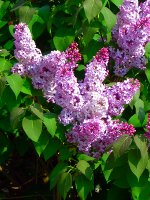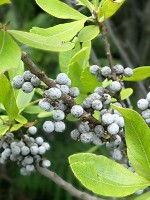Mon-Fri 9am - 5pm Mountain time
Common Purple Lilac vs Northern Bayberry
Syringa vulgaris
Myrica pensylvanica
NOT AVAILABLE THIS SEASON - MIGHT RETURN
Common Purple Lilac is a popular lilac. This large shrub provides excellent privacy or wind protection in an attractive package.
Lilac flowers are pleasantly fragrant and add a beautiful lavender colour to your property. Common Purple Lilac is cold hardy, easy to grow, and can tolerate most soil types.
Some people alternate villosa and common purple lilacs to create the impression that the hedge is in flower for almost a full month with the common purple flowering about 2 weeks sooner than the Villosa Lilac.
Northern Bayberry makes an excellent hedge or feature shrub. It will retain its leaves in warmer climates but drops them in colder areas. They produce blue-grey berries that have a wax coating on them that can be used to make candles or soaps.
In colder hardiness zones the leaves turn an attractive orange to red colour in the fall, making it a striking addition to your landscape.
Northern Bayberry is native to Nova Scotia and tolerates both drought and wet conditions. It is also a nitrogen fixer that tolerates poor soil conditions.
Common Purple Lilac Quick Facts
Northern Bayberry Quick Facts
Toxicity: Warning: The wax from bayberry fruit is considered toxic and may be carcinogenic.
In row spacing: 0.9 m (3 ft)

